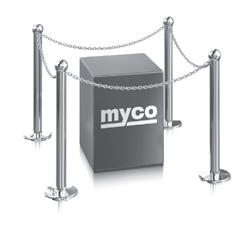
19 minute read
FUNDAMENTALS
Still More Game Changers
The last few issues I’ve been working on this “game changer” concept. (“What, again?” you ask. Why, yes, I am going to get another column out of it. The response has been pretty good.)
Seriously, I had another piece of feedback that hit the mark. It got to me via LinkedIn…incidentally, a networking game changer in my opinion.
Mike,
I just read your article in the most recent issue of LP Magazine…electronically no less. Loved the “green bar” reference! I think we’re currently in the midst of the next game change event in the LP industry. I see it similar to the game change in HR 10-15 years ago—talent. It ranges from talent assessment, placement, and development. Carpenters use the same tools, but we know the best ones produce a better product. Something drove them a little harder or someone knew to manage them a certain way and now they produce a little better. I think the next cycle of LP game changers might be organic. Have a great 2011.
Greg
When I began my career (yes, we had running water and indoor facilities), the majority of “security” or “LP” directors I met were men with a law enforcement background. I’m not offering an opinion about the effectiveness, just stating a fact.
Over time, the security label faded. LP has hung around while being joined by “AP.” More and more individuals who grew up in the business as I did took on leadership roles. These folks, not all men by the way, brought different backgrounds, educational disciplines, experiences, and perspectives to the AP or LP world…(call it what you’d like since RSFTIP* seems a bit too long).
I mentioned in passing the diversity in gender; but diversity as a whole has improved in our business. That evolution brought more perspective and challenged thinking. An interesting and amusing (to me at least) side note is diversity is a journey, not a destination. If you have a goal of being “more diverse,” then 100 percent of anything fails to meet that goal. Think about it and if you’re not amused, send me a note. I’ll explain.
Back to talent. Part of the evolution is education and research. In the early ‘90s the University of Florida began the National Retail Security Survey, which continues today under the tutelage of Dr. Richard Hollinger. That survey has provided valuable statistical data for organizations to rely on to fund programs and dedicate resources.
I think I’ve read somewhere about a magazine for our profession being around for the last ten years. Check out the May-June issue or try the website www.LPportal.com.
Today the Loss Prevention Research Council digs deeper into practical applications and theories; sometimes confirming what has long been suspected and other times delivering a head shaking, “How about that!”
Finally, education around professional development has moved forward. The Retail Industry Leaders Association, Food Marketing Institute, and National Retail Federation LP conferences have all raised the bar in the twenty-something years I’ve attended.
In 1977, after twenty years of fixing to get ready to, ASIS issued its first CPP designation and today recognizes just under 10,000 CPPs around the world. In the last ten years ASIS also introduced the PCI and PSP. (No information is on their website regarding number of designees thus far.)
Founded in 1988, the Association of Certified Fraud Examiners (CFE) claims about 55,000 members.
The Center for Interviewer Standards & Assessment (CISA) has recognized about 1,100 CFIs in its first ten years.
Even younger on the development board, we have the Loss Prevention Foundation’s LPQ and LPC designations. Both are retail specific and provide for college credits. In reviewing the curriculum for the LPC, it has much more than a security focus. Business matters in the LP industry.
So in today’s world we have a leadership pool more diverse in all aspects, with improved information, research, and educational opportunities. Isn’t that a game changer?
by Mike Marquis, CFI
Marquis is currently an assistant vice president of loss prevention with the tJX companies. his more than twenty-four years of lP experience includes senior leadership positions with limited brands and urban outfitters. Marquis invites your comments at mike_marquis@tjx.com. the opinions and commentary expressed by Marquis do not necessarily represent the tJX companies or any of its divisions.
feature
lP MANAGEMENT
REFlECTING oN QuAlITY RECRuITMENT ANd RETENTIoN

Let’s face it—the bottom line to any corporate organization is the profit margin. However, those in executive management should always be mindful that quality of service drives the margin. Factors that lead to high-quality service are often the result of well-retained employees, and this human element is the focus of this article. Specifically, all management levels need to be mindful of what policies work, what don’t work, and what looks promising.
Recruitment and Training
Think back to when you first joined your company. What was your initial impression of the first few people you met when you went in for the initial interview? Do you remember their general attitude about the company?
Chances are more likely than not that your initial impression was positive. Perhaps this is why you stayed with the company. Do you think the same attitudes are being conveyed to new recruits today? If not, you might consider those colleagues who left the company. What was it about their experiences that differed from yours that made them leave?
These questions remind us of the importance of first impressions. We already know the value of a good first impression, but we should ensure that we are practicing what we preach with both customers and employees.
Consider, for example, the case where a prospective employee is brought in for an interview. During this interview, the prospect is asked to complete some paperwork and is given more detailed information about the job than originally advertised. The prospect is informed that he or she needs to agree to the current, although possibly out-of-date, employee handbook, sign a confidentiality agreement, and sign another paper agreeing to be charged for their background check and uniforms if hired. The prospect agrees, signs the papers, and is subsequently hired.
Consider further that during the course of their training, various colleagues are bad-mouthing the company. It appears that not everyone agrees with corporate policy, and that various mistakes are made, such as supervisors not reporting work hours on time, and word-of-mouth policy conflicting with written policy. Further, whenever a corporate representative comes by, a meeting is held, and various promises of healthcare, pay raises, and new uniforms are discussed and promised. At first, these are highly motivational talks, but after very little follow through, employees are becoming disgruntled. How long do you think it will be until this new employee quits, or starts looking for employment elsewhere?
You might think that this example is fictitious, but without revealing the employer, I do admit that all this happened to me during an entry-level job in loss prevention. It was also later discovered that this same company was making a profit on the uniforms that it required its employees to buy brand new and at full price. In reality, many of these uniforms were worn and missing pieces, such as buttons and loops. Contrast this with a completely different company that I worked for, and you can tell why this second company was better at retaining employees and doing so at lower wages. Specifically, the other company tossed out free uniforms to its employees. “Need a new shirt?” the supervisor would ask. “No problem, what size are you again?” He would then toss one of the surplus shirts at me after pulling it from the
The lowest level of the LP organization might be a store-level associate, detective, or security guard. Whatever your company’s title for this position, it is imperative to remember that these are the individuals who are the backbone of your organization and ultimately your LP success.
back stock room. He rarely had to order supplies; in fact, he was always prepared. Perhaps this had to do with his previous experience as a Marine, or maybe the company treated him well, and he sought to take care of his own in the same manner. Whatever the true cause, he left a lasting impression.
The Carrot and the Stick
My experiences are not always the same as the next person’s, but the point is that in both cases, the corporate company had expenses, but one company sought to use a business model that set the tone by making it clear that the employee would be paying all incidentals. This may have seemed appropriate with the initial wages advertised in the job opening, but overall morale went down after the deductions were made, and monthly paychecks were mailed out. The other company masked these expenses from the employee in their business model, and even though the wage was a bit lower as advertised, it was always the wage earned each and every pay period…no deductions. There are basic costs to doing business, but ways to make these costs appear as incentives for employees rather than burdens also exist.
For example, if you as the supervisor provide a new uniform for me and I pay for it, well, it better be perfect and pristine because that’s my hard-earned money. Contrast that when you give me one with no questions asked and at no cost to me, then I’m going to feel like I owe you one. In this latter situation, I’m more inclined to be a more motivated employee, and in the long run, I’m going to remain loyal to you because you provide for your own. Evidently, do you really want an employee who later quits having a shirt with your company logo on it? Imagine the ramifications of that former employee running around town misrepresenting your company in his or her newly discovered pajamas, painting shirt, or
continued on page 52
When it comes to civil recovery, how important is brand protection to your company?
At Palmer, Reifler & Associates, we work closely with our retail clients to provide customized legal representation that is right for them. Our team of attorneys is integral to our civil recovery process, ensuring important legal standards and protections, while optimizing recovery performance.

PROTECT YOUR BRAND.

Place your trust in the law firm with a focus on Civil Recovery Law.
ORLANDO | ATLANTA | CHICAGO | DALLAS LOS ANGELES | LONDON | TORONTO Toll-Free in the U.S.: 866.875.6565
P A L M E R R E I F L E R . C O M

continued from page 51
what have you. If you retain ownership over the uniform, you can require that they give it back. If the employee paid for it, then it legally belongs to them.
Of course, uniforms alone are not the only factor that’s going to ensure my loyalty. In fact, I need a clear set of guidelines and feedback to know when I’m doing something right and when I have failed to meet the standard. If you establish rapport with me, give me respect, give me the opportunity to respect you back, and you acknowledge this, then we might have a more successful relationship as supervisor and subordinate. This is the essence of mutual respect.
For example, if I show up late to my shift, then you need to make it clear that the long-term consequences of this action might lead to termination. At the same time, you, as supervisor, should submit my correct work hours on time so that I am properly paid and not underpaid. Don’t give me a reason, no matter how ill-conceived, to justify my arriving to work late on Monday because you don’t usually pay me on time. I’m only human, and I will mess-up sometimes and respond to your directives, but I will also be more inclined to follow your example and leadership. After all, someone saw you fit enough to be supervisor, and if I follow in your footsteps, then one day I might be so lucky to also have a leadership position. Even if there are no future openings, grooming me to be the next supervisor might make me an ideal associate to train incoming recruits to the entry-level positions.
It might be more appropriate to offer more carrots than sticks. Remember the first company I mentioned above (hereafter referred to as “Company A”)? They offered many promises that never went fulfilled, including healthcare and wage increases among others. They even went so far as to give employees a 20 percent finder’s fee if we brought in new clients. Yet, these were lofty goals and rarely, if ever, became fulfilled incentives. They never even considered the cost-free incentive of recognition.
Contract that with the attitude of the second company mentioned above (hereafter referred to as “Company B). This company was already motivating me to do my best, and as it was, I not only met, but exceeded their expectations within the first few months of my employment. Every month the director of safety would hold a meeting and explain to us what we did right that week as a group and where we could improve. He might even offer other insights into company directives and policies as they related to our security unit. Being an undergraduate student at the time, the free food alone was enough to compensate my time for the meeting, but then the supervisor surprised me. He asked me to stand in front of the group and began to express his admiration for my dedication as an employee. I was presented with a certificate stating “Officer of the Month,” a ten dollar gift card to one of our vendors, and a company polo shirt to add to my casual wear. He also treated me to breakfast the next morning. I was not used to the idea of being praised in public, but it surely made me feel appreciated.
I can only guess how much this actually set the company back.
In fact, I wouldn’t be surprised if he actually paid for this out of his own pocket money. I was not shown any preferential treatment, but I was kindly rewarded for my efforts as a model employee that month, nothing less and nothing more.
Supervisors and mid-level management need to set the proper tone for objective integrity and high levels of excellence in all moral standards. Let’s work to improve our approach with how we do our job and manage our workplace.
What Is a Model Employee?
Think of it like this. The lowest level of the LP organization might be a
store-level associate, detective, or security guard. Whatever your company’s title for this position, it is imperative to remember that these are the individuals who are the backbone of your organization and ultimately your LP success. They are in many ways your public relations officers. Even if they don’t issue statements, they are surely out there interacting with your customers, your internal associates, and the various would-be suspects who might be trying to steal your property. The friendlier a face to an internal client, the more charismatic a personality to patrons, and the more effective skills used in approaching and handling shoplifting suspects are all often characteristics of a high-quality, first-responder-type employee. These first responders have the highest level of discretion, and they need to know that they have the company’s utmost respect and trust. Investing in the factors that instill these high-level qualities in model employees is paramount to minimizing loss and maximizing profit margins, which, of course, is the goal of your LP organization.
Don’t Discriminate, Be Ethical
Once upon a time, Company A was willing to discriminate on the type of employee it wanted to hire. Granted, retailers have a right, if not a duty, to weed out those with a criminal record and less than trustworthy integrity. However, I’m referring to the type of discrimination based on demographics and related characteristics. For example, Company A realized that I had a unique talent for writing job descriptions and a direct connection with the local job listing board at the nearby university and surrounding community. The future CEO, who happened to be the son of the founder of the company, asked me to help write a job description. He wanted to include a preference for applicants with loss prevention or military experience, which was fine. But he also stated, “I would prefer if they are older than 25 and married.” Why? “They are less likely to leave because they need to work.” I paused.
Had anyone in this company ever written a real job description before? I’m not sure. I made many pleadings to them that, at the very least, they had to consider there was a campus of nearly 30,000 students nearby to advertise to. Of all those who answer the ad, they could choose the best and brightest. Why did they have to be older than 25? Why did they have to be married? Didn’t this company check references and examine a prospect’s previous length of employment and other factors that are indicative of a good employee?
Company A was already having issues with employee retention, and this just didn’t make any
We Do Retail
And We Do It Well!
In today's difficult economy, finding a partner who provides high quality service with value based pricing is a top priority for all retailers. At Bass Security, we have worked hard to achieve this motto for over 35 years.
Retailers in North America have found that whether they need mechanical security solutions for locks, keys, safes and panic hardware, or electronic security solutions for CCTV, EAS, Alarms, and Biometrics, price and quality are important to them. At Bass Security, we are dedicated to delivering value pricing along with high quality service.
sales@bass-security.com www.bass-security.com
Your Single Source for Mechanical and Electronic Security Services
continued from page 53
sense to me that the managers spent very little time trying to understand why. I pointed out that company couldn’t discriminate by age. Still, they were insistent. I suggested to them that once applicants come into the interview and fill out paperwork, managers will know such demographics, but I pleaded that they not reject an otherwise highly qualified younger, single candidate. The manager argued that college students might move on after graduation. My response was that hiring college students was a more ideal approach than what was already in place. In the long run the company would save on paying for certain long-term expenses, such as health insurance and unemployment, and that students might be motivated to work harder for the higher wages. Because of poor retention, it appeared that the local non-student population was refusing the job offering from this company. Further, how did they know that some of these potential employees wouldn’t stay? They didn’t even want to get to know them.
Perhaps of all other discriminatory decisions, I was most dismayed at one in particular. I suggested hiring more female associates because part of our constituent base for the company was female residents at one of our property locations. Didn’t it make sense to represent that population? Specifically, one of our duties was to perform random room searches and inspections, which was allowed in the resident contracts. But what of those female residents’
The bottom line to any corporate organization is the profit margin. However, those in executive management should always be mindful that quality of service drives the margin. Factors that lead to high-quality service are often the result of well-retained employees.
comfort level? Did it not make sense to hire at least one female associate?
I expected the company’s argument would be that no females had applied. However, I was shocked to learn it was simply prejudice. Specifically, I was told that some persons were scolded in the past due to employees dating. One manager even made the comment that most females wouldn’t be able to tolerate the amount of physical labor involved in the daily job. Really? The job involved walking around the properties, investigating cases, and carrying devices weighing no more than eight pounds. They couldn’t be serious could they? Every other company I had worked for, including law enforcement and private security, had a more diverse employee population. Surely they were joking and didn’t mean it. Yet, I could find no evidence to the contrary.
The point here is that supervisors and mid-level management need to set the proper tone for objective integrity and high levels of excellence in all moral standards. Whether these standards are directly specified by the corporation or not is irrelevant. A little bit of common sense and honorable aptitude never hurt anybody. Let’s not lose sight of our goals by becoming Company A. If we are Company A, let’s work to improve our approach with how we do our job and manage our workplace.
Final Thoughts
This article is meant only as a brief treatise on an effective approach to a management style as it affects recruitment and retention. I don’t seek to exhaust every possible and effective strategy for creating a thriving work place in loss prevention, but I do think it not too much to highlight a few key lessons learned in unit understanding, unit morale, and workplace cohesion. Many of these lessons are various themes identified in conversations with both loss prevention associates and supervisors. Here are a few items to consider: ■ Treat employees with mutual respect. ■ Offer more carrots (incentives) than sticks (punishments). ■ Praise in public and criticize in private. ■ Set the example that you want your employees to follow. ■ Encourage professional development. ■ Most of all, be ethical.
RYAN KELLY is currently a doctoral student in criminology. His work experience includes college instructor, campus police, loss prevention associate, and law clerk. Kelly’s community service ranges from volunteering as a community first responder to membership in the Civil Air Patrol to election to the city council at the age of twenty-three. Professionally, he has contributed to the Encyclopedia of Forensic Science on topics, including anthrax murder investigation and crack cocaine. He currently serves as a founding member of the non-profit organization www.CrimeAcademy.org. Kelly can be reached at 724-905-0358 or ryan@ryankelly.org.





